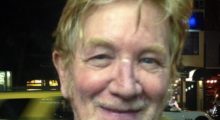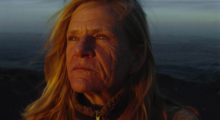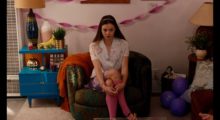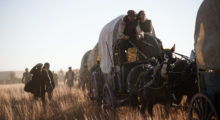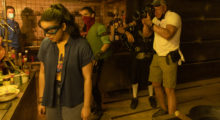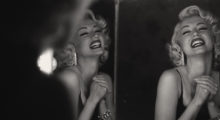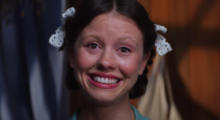18123 Results for “”
-
Remembering Director of Photography Tom Richmond, 1950-2022

This piece has been updated after publication with comments from Keith Gordon. — Editor Director of photography Tom Richmond, who shot numerous seminal features that launched many directorial careers, died yesterday in New York City. He was 72. Tom’s career began in the early ’80s. After graduating Harvard with an undergraduate photography degree and then going on to study at AFI, he worked second camera on Alex Cox’s Repo Man and was camera operator on Oliver Stone’s Salvador, among other credits. After several low-budget comedy and horror films, Tom was director of photography on two higher-profile films: Cox’s Straight to Hell […]
by Scott Macaulay on Jul 30, 2022 -
“I Want to Be the Rod Serling of Cinematography”: An Interview with Little Odessa DP Tom Richmond

The following interview with director of photography Tom Richmond appeared in Filmmaker‘s Winter, 1995 issue. Richmond died yesterday in New York at the age of 72, and this interview is now published online for the first time. — Editor “I want to be the Rod Serling of cinematography,” says Tom Richmond, whose distinctive and varied lensing has graced three recent films: the “Tex Avery meets Bonnie and Clyde” Love and a.45; the hyper-realist heist noir Killing Zoe; and Little Odessa, James Gray’s intimate epic about Brighton Beach’s Russian mafia. “The way Serling could get into you…”Richmond continues. “I want [my […]
by Scott Macaulay on Jul 30, 2022 -
“We Can Shoot the Sun and the Characters Dramatically, but the World is Humble”: Writer/Director Max Walker-Silverman on A Love Song

The sun is harsh in Max Walker-Silverman’s A Love Song. Intense in the mid-day, it beats down on Faye (Dale Dickey) — ruddy, her face lined by hard living, her blonde hair lightened further by all the incandescent days. Ensconced in her small trailer sitting in a lakeside patch of dirt somewhere in Colorado, the widow waits for a man, also familiar with loss, she knew decades ago. She wrote to him — will he show up? It’s not a spoiler to reveal that he does, in the form of Wes Studi, and theirs is a bittersweet, gently melancholic connection […]
by Scott Macaulay on Jul 29, 2022 -
“It Came Out of Me Almost Fully Born”: Writer/Director Lena Dunham on Her New Feature, Sharp Stick

It’s been 13 years since Lena Dunham emerged: first with 2009’s web series, Delusional Downtown Divas and the feature Creative Nonfiction, then, a year later, with breakthrough Tiny Furniture, an intensely personal, incredibly low-budget film that follows a recent college grad named Aura (Dunham) struggling to find her place in her hometown of New York City post-Oberlin. Supported by a cast of Dunham’s real-life friends and family, Tiny Furniture was a critical success that directly sprouted the quintessential Girls, the HBO series that depicts millennial mania, malaise and, at times, loathsome mediocrity. Five years after Girls’s final season, Dunham’s work is less focused on self-reflection […]
by Natalia Keogan on Jul 29, 2022 -
“We Did Not Have an Interior to Shoot for Eight-and-a-Half Episodes”: DP Christina Alexandra Voros on Her Emmy-Nominated 1883 Work

“The landscape is its own character,” says 1883 cinematographer Christina Alexandra Voros. It’s not an unusual declaration for an epic outdoor adventure, until Voros adds, “And that character was the biggest diva on the show.” A prequel to Paramount+’s popular Yellowstone series, 1883 subjected its crew to both a stifling Texas summer and a frigid Montana winter to trace the Dutton clan’s westward journey via wagon train. “It was punishing,” said Voros. “It was either raining, windy or just plain freezing, or it was 500 background people in downtown Ft. Worth sweltering under the August sun in wool clothing.” Braving […]
by Matt Mulcahey on Jul 28, 2022 -
Trailer Watch: Andrew Dominik’s Ana de Armas-Starring Blonde

“Ms. Monroe, it’s time,” are the first ominous words heard in the just-released trailer for Andrew Dominik’s long-awaited Netflix production, Blonde, based on Joyce Carol Oates’s book about actor and movie star Marilyn Monroe. Ana de Armas plays Monroe in the dark drama. In addition to first glimpses of de Armas’s performance, among what’s striking about the trailer is Chayse Irvin’s cinematography, which, across scenes, instantly recalls the different period photographic styles — in cinema, paparazzi shots, and media and magazine coverage — associated with Monroe’s depiction. Interestingly, Blonde is Irvin’s second credit this year. The BlacKkKlansman DP also shot […]
by Scott Macaulay on Jul 28, 2022 -
“Over-Coverge is the Enemy of Style”: DP Jules O’Loughlin on The Old Man and Ms. Marvel

In Disney’s Ms. Marvel, a teen in an exuberantly colored Jersey City discovers super powers after slipping a magical bangle on her wrist. In FX’s The Old Man, a septuagenarian dusts off a long-dormant aptitude for violence when his former life as a CIA operative catches up with him. In the overlapping Venn diagram of these seemingly disparate shows, you’ll find cinematographer Jules O’Loughlin. The Australian DP shot two episodes of each series, which also share critical flashbacks set on different continents than their main story, as well as shoots that were greatly affected by COVID. With both shows now […]
by Matt Mulcahey on Jul 27, 2022 -
Venice Film Festival Announces 2022 Lineup

The lineup for the 79th Venice Film Festival is now live, one day after Noah Baumbach‘s adaptation of Don Delillo’s novel White Noise was announced as the opening night film. The films announced today include Andrew Dominik‘s Blonde, Darren Aronofsky‘s The Whale, Joanna Hogg‘s The Eternal Daughter, recently jailed Iranian director Jafar Panahi‘s No Bears, Frederick Wiseman‘s narrative turn A Couple and more. White Noise marks the first time that a Netflix film serves as the festival’s opening night film. The streamer is also present with Dominik’s Blonde, the Nicolas Winding Refn mini-series Copenhagen Cowboy and Alejandro González Iñárritu’s Bardo (or False […]
by Filmmaker Staff on Jul 26, 2022 -
Trailer Watch: Ti West’s Pearl

Watch the trailer for Pearl, the second film from director Ti West to be released this year. Back in March, we got the ’70s slasher throwback X, and Pearl is a prequel that charts the origin story of X‘s geriatric killer. Mia Goth, who co-wrote the screenplay with West, stars as the titular character during her young womanhood. While filming X, Goth portrayed both the film’s final girl and crazed killer. It appears she sheds the extensive prosthetics and dual performance in Pearl. The film will be released in theaters by A24 on September 16.
by Filmmaker Staff on Jul 26, 2022 -
Back to One, Episode 213: Angourie Rice

She’s only 21, but Australian actor Angourie Rice has earned respect in Hollywood for stacking up diverse roles in The Nice Guys, The Beguiled, Jasper Jones, Mare of Easttown, not to mention a few Spider-Man movies. Now she has her first starring role in Honor Society for Paramount+. She talks about how it helped her to be able to relate so much to her character in that film, and why talking directly to the camera was oddly easy. We chat about her podcast, The Community Library, which is a celebration of literature and storytelling of all kinds. This leads to […]
by Peter Rinaldi on Jul 26, 2022
